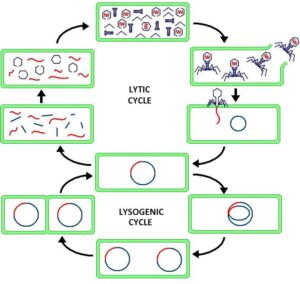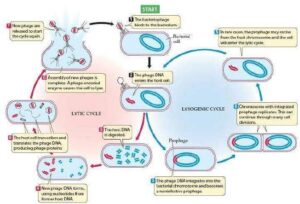Back to: MICROBIOLOGY 100 LEVEL
Welcome to class!
Hello brilliant mind! I’m so glad to see you here again—ready to learn something new and exciting. Today, we’re going to look at Viral Replication Cycles—Lytic and Lysogenic. You might be surprised to know that viruses can’t reproduce on their own. They need to take over another living cell to multiply. Imagine a person sneaking into a factory and using the machines to make copies of themselves—that’s exactly how viruses behave. Let’s understand how they do this
Viral Replication Cycles (Lytic And Lysogenic).
What is Viral Replication?
Viral replication is the process by which a virus makes more of itself. But unlike bacteria, viruses are not living cells. They don’t have the tools needed to grow or divide. So, what do they do? They invade a host cell—like a hijacker—and use the cell’s machinery to create copies. There are two main ways they do this: lytic cycle and lysogenic cycle.
The Lytic Cycle
This is the quick and destructive path. The virus enters a host cell, takes over, makes copies, and then bursts the cell open to release new viruses.

Stages of the Lytic Cycle:
Attachment: The virus attaches to a specific site on the host cell’s surface.
Penetration: It injects its genetic material (DNA or RNA) into the host cell.
Biosynthesis: The host cell is now hijacked and forced to make viral parts—new viral proteins and genetic material.
Maturation (Assembly): All the parts come together to form complete new viruses.
Lysis (Release): The host cell bursts (lysis), releasing many new viruses to infect other cells.
Example: T4 bacteriophage attacking E. coli uses the lytic cycle.
The Lysogenic Cycle
This is the sneaky and silent route. Instead of immediately taking over, the virus becomes part of the host’s DNA and stays quiet for a while.
Stages of the Lysogenic Cycle:
Attachment and Penetration: Just like in the lytic cycle.
Integration: The viral DNA becomes part of the host’s DNA. It is now called a provirus or prophage.
Dormancy: The virus lies low. As the host cell divides, it copies the viral DNA too.
Activation: At any point, due to stress or other signals, the virus can “wake up” and enter the lytic cycle, making and releasing new viruses.

Example: The virus that causes cold sores (Herpes simplex virus) can stay dormant and return later.
Think of the lytic cycle like a thief breaking into a house, using everything, then blowing up the house and running away. But the lysogenic cycle is like someone hiding quietly in the house, pretending to be part of the family, until one day, they take over suddenly.
Summary
- Viruses can’t reproduce by themselves—they need a host.
- In the lytic cycle, the virus makes new copies quickly and destroys the host cell.
- In the lysogenic cycle, the virus hides inside the host’s DNA and can stay inactive for a long time before becoming active.
- Both cycles allow the virus to spread, but the lysogenic cycle gives the virus a “silent” option.
Evaluation
- Why do viruses need a host cell to reproduce?
- What happens to the host cell in the lytic cycle?
- What is the viral DNA called when it is part of the host DNA in the lysogenic cycle?
- Which cycle is faster in producing new viruses?
- Give one example of a virus that can undergo the lysogenic cycle.
Now you understand how these tiny invaders work behind the scenes. Whether they attack loudly or wait quietly, you now know their secret tricks. Keep learning with Afrilearn—you’re growing stronger every day!
